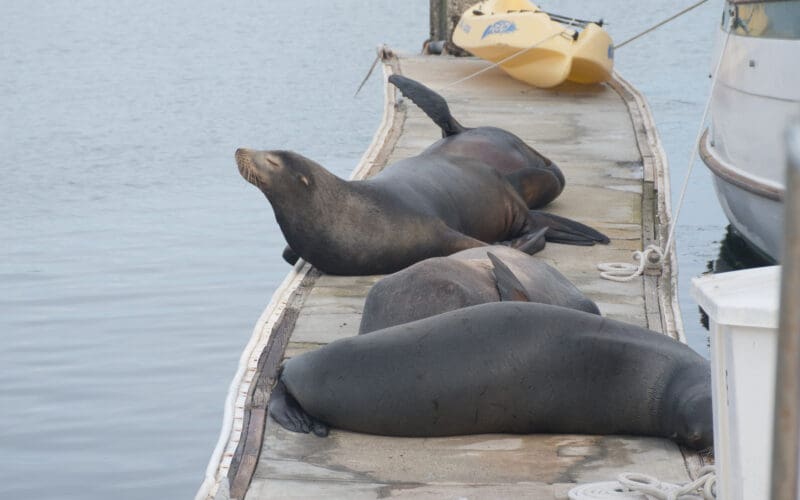By Rob MacFarlane

When I’m cruising my usual practice is to anchor out each evening. As needed, however, my Morgan 45 Tiger Beetle will spend a night in a marina, which is great for a large shore-side food shopping, meeting an arriving friend, and doing work at the yard. I’ve found that visiting random marinas requires a variety of relatively simple accouterments to make life at the dock proceed smoothly.
Electricity
AC power is unpredictable. The connections I’ve run into so far are 125v/20amp (Canada), 125v/30amp (USA), 125v/50amp (big slips in USA/Mexico), 125/250v/50amp (other bigger slips USA), as well as no power at all, which happens often. As I visit more marinas the boat collects more AC adapters. Beetle is set up for 125v/30amp 60Hz shore power — and I never know where that power might be available relative to the AC jack mounted in the cockpit. I carry two 50-foot power cords that can join together as one long 100-foot power cord if the dock-side connection is far away. The further afield you travel the more AC adapters you’ll collect.
Water
Water at the marina often isn’t available. When it is I ask the marina manager if the water is potable — often it is not. I carry two 75-foot 1-inch diameter fire hoses with thick nylon covers that can be wound flat for stowage. These fire hoses are used by fire fighters and can be ordered up with various end fittings. So far the three-quarter-inch garden hose end-fitting has worked well. I also keep a squirter nozzle in the bag with the hoses. The nozzle makes it easy to conserve water as needed.
Bottom depth
I’ve found it important to verify the controlling (minimum) depth in a slip. The marinas I’ve visited generally are silting in, shallow, and the harbor masters do not necessarily know the controlling depth for a given slip. Beetle draws 8 feet 2 inches which limits the spots I can tie up. Communicating in advance with a marina is helpful:While every harbor master knows the length and breadth of their slips, few know the water depth. I often hear: “I’ll ask someone to check and get back to you.” Communicate the boat’s needs well in advance as it may turn out you can’t get across a particular marina’s entrance shoal, or that once inside you find the fairway deep but the slips not. It’s no fun to motor halfway across an entrance only to bottom out and then try to pivot on the keel to retreat.
Dock conditions
Take a good look at the cleats and the docks — many docks are wonderful, some are fair, and some are just plain falling apart. No matter the condition of the docks, definitely inspect each mooring cleat you’re planning to tie to. I like to walk around the slip and press hard on the cleats with my foot — if they wiggle that’s not a good sign. Cleats are often lag-screwed into the dock’s waler boards and quickly forgotten by the marina management. The hardware commences corroding and will turn into tooth-pick thin metal that can yank out of the wood with little effort.
I carry extra-long dock lines as I can’t predict where cleats will be located, nor how long the slip might be. Sometimes I’ll be in a 100-foot slip and those cleats are both huge and far apart — it’s helpful to have 60-foot dock lines.
Examine the docks for metal bolts, nails, and other fasteners protruding into the berth because these will puncture fenders, eat fiberglass hulls, and poke holes in a dinghy. Ideally I will visit the marina first to walk the dock and inspect the slip prior to bringing Beetle in. Then at least I know where the problems are located.
Fixed docks
Fixed-concrete (non-floating) docks are relatively common near the equator where the tidal change is minimal. Using such a dock I need to tie and fend off the boat such that I’m certain the deck can not slip beneath the concrete. If that happens and the boat goes up on the tide while under the concrete I can expect significant damage as stanchions are crunched under the dock. It’s helpful to have many fenders and heavy cloth (old carpet works best) to protect the fenders as they ride up and down against concrete docks.
Med-mooring
I have not done much bow-out/stern-to Med-mooring to the anchor set off the dock; as a singlehander this is a recipe for disaster and I will instead opt to anchor out away from all the frivolities of Med-mooring. I use the dinghy to shore rather than Med-moor.
Theft/security
At anchor I’m not too concerned about a random person wandering over uninvited; in a marina it’s an entirely different matter. Being close to shore also means shore is close to you, and it’s likely that the local waterfront folks know more about the marina’s security than someone aboard a visiting boat. Assume that there is zero security to the docks, as there may be missing/borrowed gate keys, damaged fences, and gates that are simple to bypass. I’ve added an internal lock for the companionway hatch and washboards, such that I can open the lock in the dark without a key in case of fire. When I’m on board in the marina I always engage the lock and I sleep well at night.
Rob MacFarlane has raced and cruised as a singlehander for 30 years on San Francisco Bay, the West Coast, Hawaii, Mexico, Canada and French Polynesia.

